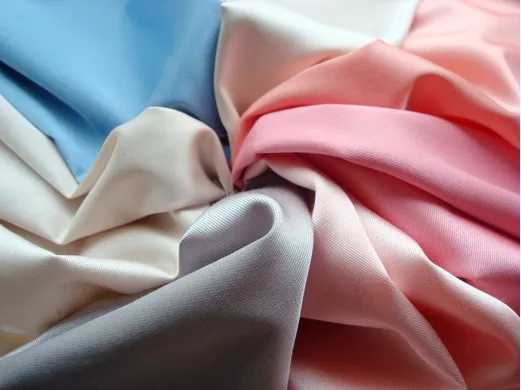
NewsInformation Center
What are the color fastness test items for printed and dyed textiles?
2022/09/19
With the development of social economy and science and technology, people pay more and more attention to and demand for textile daily-use consumer goods. Textiles as consumer goods in the process of use will be washed, light, ironing, sweat, friction and other factors, which requires the color of printed and dyed textiles with the ability to maintain a certain fastness to dyeing. Color fastness refers to the resistance of the color of textiles to various effects in the process and use. The fastness level is assessed according to the discoloration of the specimen and the staining of the undyed lining fabric. Textile color fastness test is a regular test item in the textile inherent quality test.
The International Textile Association standard color fastness requirements are: rubbing resistance, washing resistance, perspiration resistance, sunlight resistance, water resistance, ironing resistance, bleaching resistance, light sweat resistance, etc.
The color fastness required by the EU eco-textile mark adds wet rub resistance and sunlight fastness on the basis of the IATA standard. The color in nature is generally described by three attributes: Hue: the phase of the color, is the amount of color properties expressed. Chromaticity: also known as saturation, refers to the degree of purity of the color. It is associated with the vividness of the color. Brightness: also known as brightness, indicates the intensity of light reflected from the surface of a colored object. Associated with the intensity of the color.
Color fastness is the most asked question among all dyeing queries. Dyeing fastness is very demanding for the quality of dyed and printed fabrics, and the nature or degree of variation in dyeing state can be expressed by dyeing fastness. It is related to the yarn structure, fabric organization, printing and dyeing method, dye type and the size of external forces. Different dyeing fastness requirements can cause significant cost and quality differences.
The 6 main textile fastnesses are explained;
1. sun fastness; sun fastness refers to the degree of discoloration of colored fabrics by the action of sunlight. The test method can be used sunlight sunlight can also be used sunlight machine sunlight, sunlight after the fading degree of the specimen and the standard color sample for comparison, divided into 8 levels, 8 levels of the best, 1 level of the worst. Poor sunlight fastness of the fabric should not be exposed to the sun for a long time, it is appropriate to put in the ventilation dry.
2. friction fastness; friction fastness refers to the degree of color loss of dyed fabric after friction, can be divided into dry state friction and wet state friction. Rubbing fastness to white cloth staining degree as the evaluation principle, a total of 5 levels (1 ~ 5), the greater the value, said the better rubbing fastness. Fastness to friction poor fabric life is limited.
3. washing fastness; washing or soap fastness refers to the dyeing fabric after washing liquid washing color change degree. Usually use the gray grading sample card as the assessment standard, that is, rely on the original sample and the color difference after the sample fade to judge. Washing fastness is divided into 5 grades, with 5 grades being the best and 1 grade being the worst. Washing fastness of poor fabrics should be dry-cleaned, such as wet-cleaning, it is necessary to pay extra attention to the washing conditions, such as washing temperature can not be too high, time can not be too long, etc..
4. Ironing fastness; ironing fastness refers to the dyeing fabric in the ironing degree of color change or fading. This discoloration, the degree of fading is to iron at the same time to other fabric staining to assess. Ironing fastness is divided into 1 to 5 levels, 5 levels of the best, 1 level of the worst. Test different fabrics ironing fastness, should choose a good test with iron temperature.
5. sweat fastness; sweat fastness refers to the degree of color loss after dyeing fabric dipped in sweat. Sweat fastness due to artificially prepared sweat composition is not the same, and therefore generally in addition to the separate determination, but also combined with other color fastness assessment. Sweat fastness is divided into 1 to 5 levels, the greater the value the better.
6. sublimation fastness; sublimation fastness refers to the degree of sublimation that occurs in the storage of dyed fabrics. Sublimation fastness with gray grading sample card to assess the fabric by the dry heat pressure ironing treatment, discoloration, fading and white cloth staining degree, a total of 5 levels, 1 level is the worst, 5 level is the best. Normal fabric dyeing fastness, generally required to achieve 3 to 4 levels to meet the needs of wearing.
But through the International Standards Organization (ISO), the American Association of Dyers and Chemists (AATCC), Japan (JIS), the United Kingdom (BS) and many other standards, the most commonly used or wash resistance, light resistance, rub resistance and sweat resistance, ironing resistance, weather resistance and other items.
In practice, mainly according to the end use of the product and product standards to determine the test items, such as woolen textile product standards must be tested for sunlight fastness, knitted underwear, of course, to measure the fastness to sweat stains, and outdoor textiles (such as umbrellas, light box cloth, canopy material) is of course to test its weather fastness to color.
Previous: Analysis: What should be paid attention to when using Martindale Abrasion Tester
N e x t : How to use the moisture resistance microbial penetration tester correctly?




